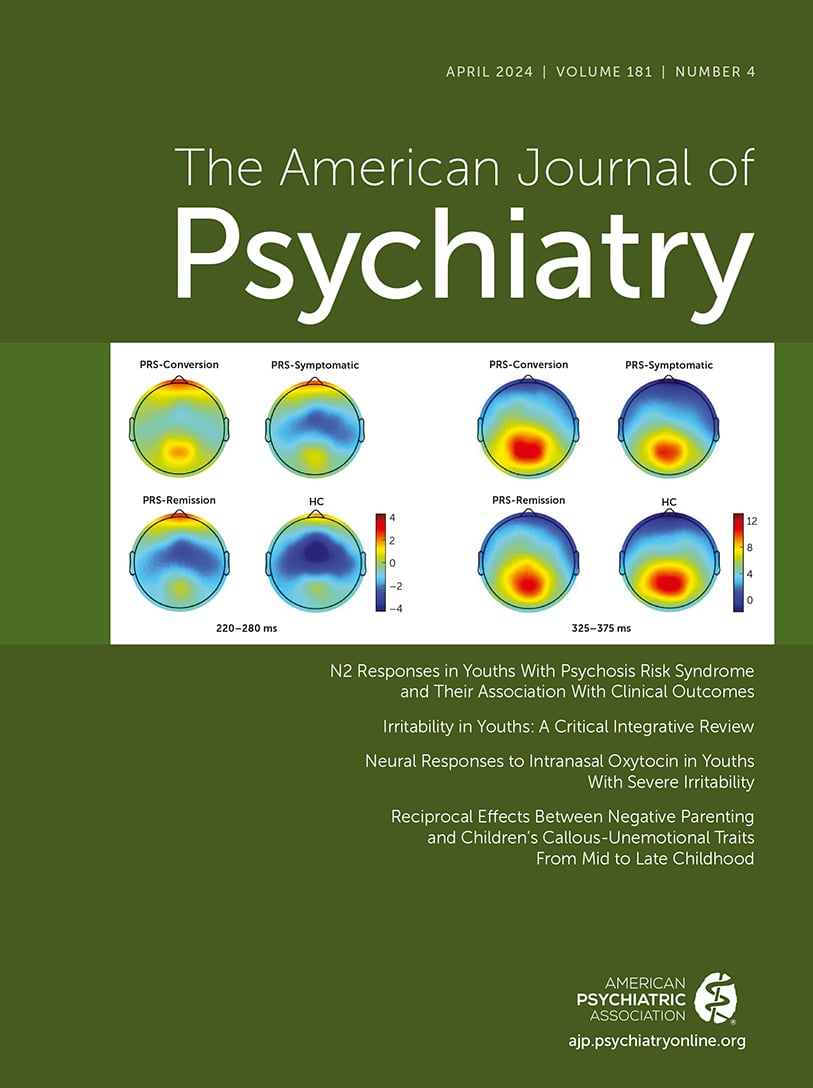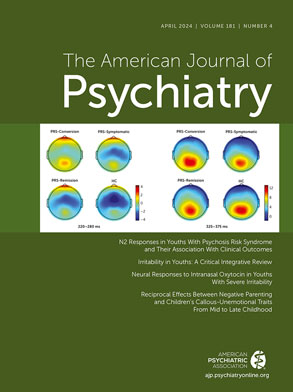Recent evidence suggests that many or most anxiety disorders emerge as a result of altered neurodevelopment. The median age at onset of anxiety disorders is between 6 and 12 years, and variation in brain function during childhood, infancy, and even near birth has been associated with risk for developing an anxiety disorder (
1). While the specific brain alterations linked to risk for and expression of anxiety are varied and not completely understood, many models are centered on excessive amygdala activity in response to mild or ambiguous threats coupled with decreased amygdala regulation by regions in the prefrontal cortex. This regulation is thought to depend in part on the integrity of the white matter (WM) tracts that connect the prefrontal cortex and amygdala, especially the uncinate fasciculus (UF).
Notably, there are known sex differences in the risk for and expression of anxiety disorders (
2). Girls have higher rates of anxiety than boys after onset of puberty (
3), and there is some suggestion that anxiety symptoms may be more easily detected in girls. There is also evidence of sex differences in the neurodevelopmental trajectories of WM (
4). Clarifying whether the neurodevelopmental trajectories associated with development of an anxiety disorder differ based on sex may help elucidate the etiology of anxiety disorders. Past work in this area has provided inconsistent results, possibly because of relatively small sample sizes and variation across samples with different characteristics.
With this framework in mind, Aggarwal et al. (
5) performed a mega-analysis combining data across three studies, which they report in this issue of the
Journal. The total data set included 295 participants between the ages of 8 and 12 years, including 163 children with anxiety disorders (ascertained by gold-standard psychiatric interviews) and 132 healthy control subjects. Participants underwent diffusion tensor imaging, and the authors performed deterministic tractography to delineate seven bilateral WM tracts: the UF, corpus callosum (CC), cingulum, internal capsule, inferior fronto-occipital fasciculus, superior longitudinal fasciculus, and stria terminalis/fornix. The primary measure for each WM tract was fractional anisotropy (FA), which generally captures the ratio of water displacement parallel to axons to water displacement orthogonal to them. In general, higher FA values are typically interpreted as indicating increased myelination and maturation, although other factors can influence FA values. While FA trajectories are nonlinear over the course of development, FA generally increases from early childhood through late adolescence (
6) and varies based on sex (
4). In addition to targeting these seven specific WM tracts, Aggarwal et al. performed a brain-wide evaluation of white matter FA to see how specific the results were to the seven tracts they examined.
The main result of the analysis was that boys with anxiety disorders had widespread reductions in FA compared to boys without anxiety disorders; no effects were noted in girls. The authors had hypothesized that increased anxiety would be linked to decreased FA of the UF, an important WM pathway that supports prefrontal cortex regulation of the amygdala. While the authors did find support for this hypothesis (in boys, at least), the result was not clearly specific to the UF, as more widespread WM changes were also detected. In the hypothesis-driven analyses, the authors reported a group-by-sex interaction such that FA was lower in boys but not girls with anxiety disorders in the UF and inferior fronto-occipital fasciculus. When dividing analyses by sex, lower FA was noted in the corpus callosum of boys with anxiety disorders compared with healthy control subjects as well. The voxel-wise whole-brain analyses revealed widespread WM changes in boys but not girls with anxiety disorders. Important contextualizing information was that anxious children in this study also had increased depressive and externalizing symptoms compared with healthy control subjects, although the results held when controlling for these covariates.
The results of this study represent an important advance for the field. Understanding the sex-specific etiologies of anxiety disorders is likely to eventually help with earlier diagnosis, the targeting of interventions and assessment of response to them, and potentially the development of new treatments. The result that the WM changes associated with anxiety appeared to be widespread and not specific to the UF is broadly consistent with models of anxiety disorders that include many different brain networks (
7). Furthermore, the results may suggest that widespread nonspecific brain alterations, such as global reductions in WM integrity, may subserve anxiety in boys. The study’s numerous strengths suggest that the results are likely to be robust. The sample size was reasonably large, especially given that all participants had gold-standard psychiatric interviews. Many important covariates were considered, including comorbid symptoms, sex hormones, and socioeconomic status.
Among the limitations of the study were that, compared to girls, the boys in the study had significantly lower symptoms of self-reported anxiety as well as nonsignificantly lower depressive and externalizing symptoms. Given that boys generally have higher symptoms of attention deficit hyperactivity disorder at this age (
3), this sex difference may indicate that there was something unique about either the boys or the girls in this sample, which could limit generalizability. An additional limitation is that it is challenging to combine analyses across different scanners with different sequences, although the authors did use analytic techniques to harmonize the data. Finally, and perhaps most importantly, while the narrow age range permitted highly powered analyses for a specific developmental epoch, a challenge is that both brain development and onset of anxiety symptoms have nonlinear trajectories from infancy through early adulthood; hence, restricting analyses to such a narrow age range could miss important associations that become evident only when viewing the entire neurodevelopmental trajectory.
Why would boys but not girls with anxiety disorders have generalized decreases in FA across WM tracts? As indicated above, it is likely important to contextualize the results within the scope of the sex-specific developmental trajectories of both anxiety symptoms and WM development. Prior to the onset of puberty, rates of anxiety disorders are roughly equal between boys and girls, with some recent work indicating that boys have slightly higher rates. After age 12, however, the incidence of anxiety disorders increases modestly in boys but dramatically in girls, such that girls have much higher rates by early adulthood (
3). Thus, of all the children who will eventually be diagnosed with an anxiety disorder by age 18, a higher percentage of boys may be identified by age 12 compared to girls. As for WM development, FA has a nonlinear trajectory over the lifespan, although some evidence indicates that there is a relatively linear increase in FA in most WM tracts over the ages of 10 to 20 years (
6). WM FA for many tracts peaks in the first few decades, followed by a decrease in FA later in life. Some sex differences have been reported in FA that depend on the specific tract, and girls may have earlier maturation of WM tracts (
4).
These sex differences in the trajectory of onset of anxiety disorders and the later detection in girls could partly explain why relationships were detected only in boys in the present study. A higher percentage of boys who will ever have an anxiety disorder would have been identified by age 12, while some of the girls in the “healthy control” group may be destined to develop an anxiety disorder in the next few years. This effect would produce greater “contamination” of the control group with girls who will soon develop an anxiety disorder, diluting the detection of possible effects. Consistent with this explanation, and underscoring the importance of the developmental perspective, the authors noted that the sex-specific results they obtained differed from results reported at other ages. The largest studies in adults have reported that anxiety is linked to lower FA of WM tracts in women but not men (
8). Similarly, in the authors’ own prior work, longitudinal associations between girls’ anxiety and the FA of WM tracts were negatively correlated (
9). It is possible that longitudinal follow-up of this cohort at later ages will reveal the same relations in girls. These possibilities underscore the importance of looking at these findings through a broader developmental lens considering both developmental change in anxiety symptom manifestation and FA development, both of which are known to have gender-specific trajectories.
It is also important to contextualize the results against the background of sex differences in emotion processing and cognitive style and related brain function. A large body of work has underscored differences in brain connectivity and function as well as cognition based on sex. In a sample of 674 participants 9–22 years of age from the Penn Neurodevelopmental Cohort, for example, girls were faster at emotional identification and nonverbal reasoning tasks, while boys were better at motor and spatial cognitive tasks (
10). There were also significant and widespread sex differences in functional connectivity as measured with functional MRI. Interestingly, the degree to which an individual had a more male-like versus female-like profile of cognition was related to whether they had a more male-like versus female-like pattern of functional connectivity. These baseline differences likely inform sex differences in the effects of brain-wide disturbances. For example, a decrease in white matter integrity across the brain may increase anxiety in boys more than girls at age 12 if they already have baseline brain connectivity that promotes worse baseline emotional reasoning. Further work is needed to determine how alterations in specific white matter tracts interact with sex differences to produce clinical symptoms.
Aggarwal et al. provide an important data point in understanding sex differences in brain trajectories associated with developing an anxiety disorder. The next step is to use data from larger longitudinal studies that track individuals from early childhood through adulthood, tracking clinical symptoms in relation to different aspects of brain development. The National Institutes of Health is currently funding several large longitudinal national cohort studies, including the Adolescent Brain Cognitive Development study, which ascertained children starting at age 10, and the Healthy Brain and Child Development study, which is recruiting pregnant mothers and following offspring longitudinally. Both studies longitudinally track thousands of children across the United States at least yearly, obtain serial MRI scans, and record clinical symptoms and a wealth of sociodemographic and other data. These studies and similar work should help elucidate brain development trajectories and risks for psychiatric illnesses from birth through early adulthood, paving the way for understanding developmental mechanisms of anxiety disorders and other mental health problems.

